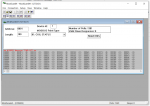I'm trying to retrieve data from an AC/DC transformer (http://www.growatt.co.nl/show-42-588.html datasheet and other technical documentation can be found in English if you scroll all the way down) using Modbus. I stuck an RS485 cable into the device with one end and into my PC through a USB connector with the other.
I then opened ModScan64 and set it up according to this video
(COM port 3, baud rate 9600, word length 8, parity none, stop bits 1). But I'm not getting any data despite the poll count going up. I'm also getting an error message that reads "MODBUS message TIME-OUT" (see attachment).
Does anyone have an idea what I'm doing wrong? I also have a siemens LOGO PLC which allegedly is Modbus-compatible. Could the solution be in that?
I then opened ModScan64 and set it up according to this video
Does anyone have an idea what I'm doing wrong? I also have a siemens LOGO PLC which allegedly is Modbus-compatible. Could the solution be in that?
Attachments
-
40.9 KB Views: 8






